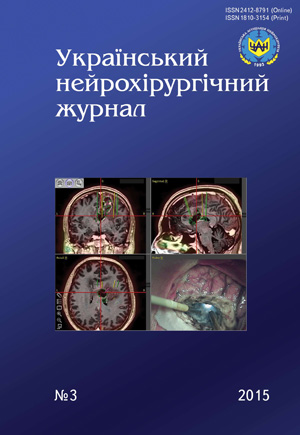Skull and brain gunshot wound during the armed conflict in eastern Ukraine. Report 3. Optimization of medical care
DOI:
https://doi.org/10.25305/unj.50054Keywords:
skull and brain gunshot wounds, penetrating craniocerebral wounds, initial surgical debridement, surgical treatment, qualified medical aid, specialized medical aidAbstract
Objective. To improve the quality of the first aid delivery in cases of skull and brain gunshot wounds.
Materials and methods. Analysis of results of treatment of 790 patients who suffered injuries to various systems and anatomic regions of a body has been performed. Both extent and quality of the medical care at all stages of evacuation of 64 patients with skull and brain gunshot wounds has been analyzed in detail. Qualified medical aid to the patients with head injuries was administered at military medical hospital, municipal and district hospitals of Donetsk and Luhansk regions.
Results. Absence of any surgical debridement of a gunshot wound was discovered in 26.5% of patients, low-quality initial surgical debridement, in 52.2% of patients, the need of re-operation, in 33.3% of patients operated during qualified aid delivery; craniocerebral complications were found in 31.3% of patients. Following treatment indicators were obtained during specialized medical aid delivery: postoperative complications were found in 15.6% of patients; re-operations were performed for 15% of initially operated patients; postoperative mortality made 5%. Combined wounds, found in 65.6% of cases, require involvement of a large number of allied specialists, which is only possible within a multi-field hospital. In the conditions of today’s military conflicts, which are characterized by wide capabilities of air transportation of patients to the hospitals, it would be more effective to minimize remedial measures at all intermediary stages and transfer such measures to the stage of specialized aid delivery.
Summary. Evacuation to the nearest neurosurgeon, avoidance of diagnostic delays, and initiation of cerebral resuscitation increase the chance of full patient recovery. Optimal results of treatment of patients with head or brain wound are only achieved when early surgical debridement of skull and brain wounds is performed by a neurosurgeon at the stage of specialized medical aid delivery in the in-patient neurosurgery department of a multi-field hospital after CT of the brain.
References
1. Chaplyk V, Oliynyk P., editors. Nevidkladna viyskova khirurhiya [Emergency War Surgery]. Lviv: Nautilus; 2015. Ukrainian.
2. Clinical Practice Guidelines [Internet]. Available at: http://usaisr.amedd.army.mil/clinical_practice_guidelines.html
3. Polishchuk NE, Starcha VI. Ognestrel'nyye raneniya golovy [Gunshot wounds of the head]. Kiev: Ton; 1996. Russian.
4. Konovalov AN, Lihterman LB, Potapoov AA., editors. Cherepno-mozgovaya travma: klinicheskoye rukovodstvo [Traumatic brain injury: Clinical Guidelines]. Moscow: Antidor; 2001;2. Russian.
5. Gaidar BV., editor. Voyennaya neyrokhirurgiya: uchebnik [War Neurosurgery: the Textbook]. St. Petersburg: MMedA; 1998. Russian.
6. Pedachenko EG, Danchin OG, Polishchuk ME, Tsymbaliuk VI. Orhanizatsiya nadannya spetsializovanoyi neyrokhirurhichnoyi dopomohy u viyskovyy chas (z•hidno oboronnoyi viyskovoyi doktryny): metod. Vkazivky [Organization of specialized neurosurgical care in wartime (according to defensive military doctrine): Guidelines]. Kiev; 2014. Ukrainian.
7. Gaidar BV., editor. Prakticheskaya neyrokhirurgiya: rukovodstvo dlya vrachey [Practical neurosurgery: Guidelines for Physicians]. St. Petersburg: Gippokrat; 2002. Russian.
8. Knuth T, Letarte PB, Ling G, Moores LE, Rhee P. Guidelines for field management of combat-related head trauma. New York; 2005.
9. Popov VS. Spetsializirovannaya pomoshch ranenym v cherep na etapakh meditsinskoy evakuatsii v gorno-pustynnoy mestnosti s zharkim klimatom [Specialized care for injured persons with skull wounds during medical evacuation in the mountain desert with a hot climate]. In: Abstract Book of All-Army Conference "Experience of Soviet Medicine in Afghanistan"; 1992. Moscow, 1992. p.43-44. Russian.
10. Usanov EI. Organizatsiya spetsializirovannoy meditsinskoy pomoshchi ranenym v cherep, pozvonochnik i perifericheskiye nervy vo frontovoy oboronitelnoy operatsii [Organization of specialized medical care for injured persons with wounds of the skull, spine and peripheral nerves in the front defensive operation] [dissertation]. St. Petersburg; 1992. Russian.
11. Akhutin MN. Organizatsionnyye voprosy khirurgicheskoy pomoshchi cherepnym ranenym [Organizational matters of surgical care to the wounded in the skull]. Zh Vopr Neirokhir Im N N Burdenko. 1943;7(1):3-7. Russian.
12. Ahhutin MN. Nekotoryye zamechaniya po povodu pervichnoy obrabotki ognestrelnykh ran [Some comments on the primary processing of gunshot wounds]. Voenno-sanitarnoe delo. 1942;(10):12-13. Russian.
13. Akhutin MN. Organizatsiya neyrokhirurgicheskoy pomoshchi v armiyakh i na fronte v nastupatel'noy operatsii [Organization of neurosurgical care in armies and at the front in the offensive]. Zh Vopr Neirokhir Im N N Burdenko. 1944;8(4):11-18. Russian.
14. Nechaev EA, Tutokhel AK, Gritsanov AI, Kosachev ID. Vzryvnyye porazheniya [Explosive Defeat]. Voyen Med Zhurn. 1991;8:7-12. Russian.
15. Orlov VP. Lecheniye ranenykh s ognestrelnymi cherepno-mozgovymi raneniyami v voyskovom rayone [Treatment of the wounded persons with gunshot craniocerebral wounds in military area]. Voyen Med Zhurn. 1991;8(46):96-100. Russian.
16. Starcha VI. Khirurgicheskoye lecheniye ranenykh v golovu [Surgical treatment of the wounded persons with head injuries]. Voyen Med Zhurn. 1984;41:56-61. Russian.
Downloads
Published
How to Cite
Issue
Section
License
Copyright (c) 2015 Andriy Sirko

This work is licensed under a Creative Commons Attribution 4.0 International License.
Ukrainian Neurosurgical Journal abides by the CREATIVE COMMONS copyright rights and permissions for open access journals.
Authors, who are published in this Journal, agree to the following conditions:
1. The authors reserve the right to authorship of the work and pass the first publication right of this work to the Journal under the terms of Creative Commons Attribution License, which allows others to freely distribute the published research with the obligatory reference to the authors of the original work and the first publication of the work in this Journal.
2. The authors have the right to conclude separate supplement agreements that relate to non-exclusive work distribution in the form of which it has been published by the Journal (for example, to upload the work to the online storage of the Journal or publish it as part of a monograph), provided that the reference to the first publication of the work in this Journal is included.









